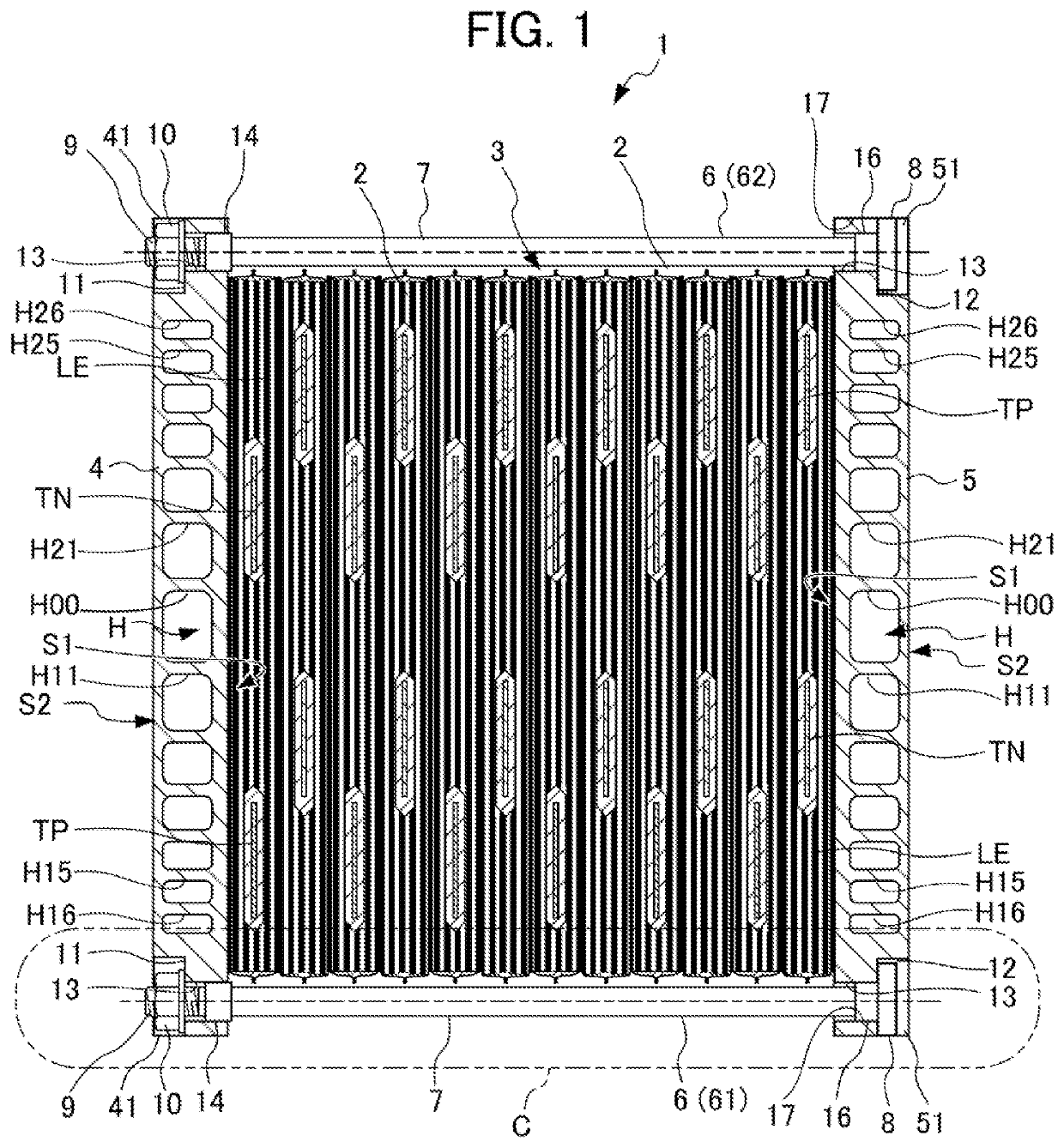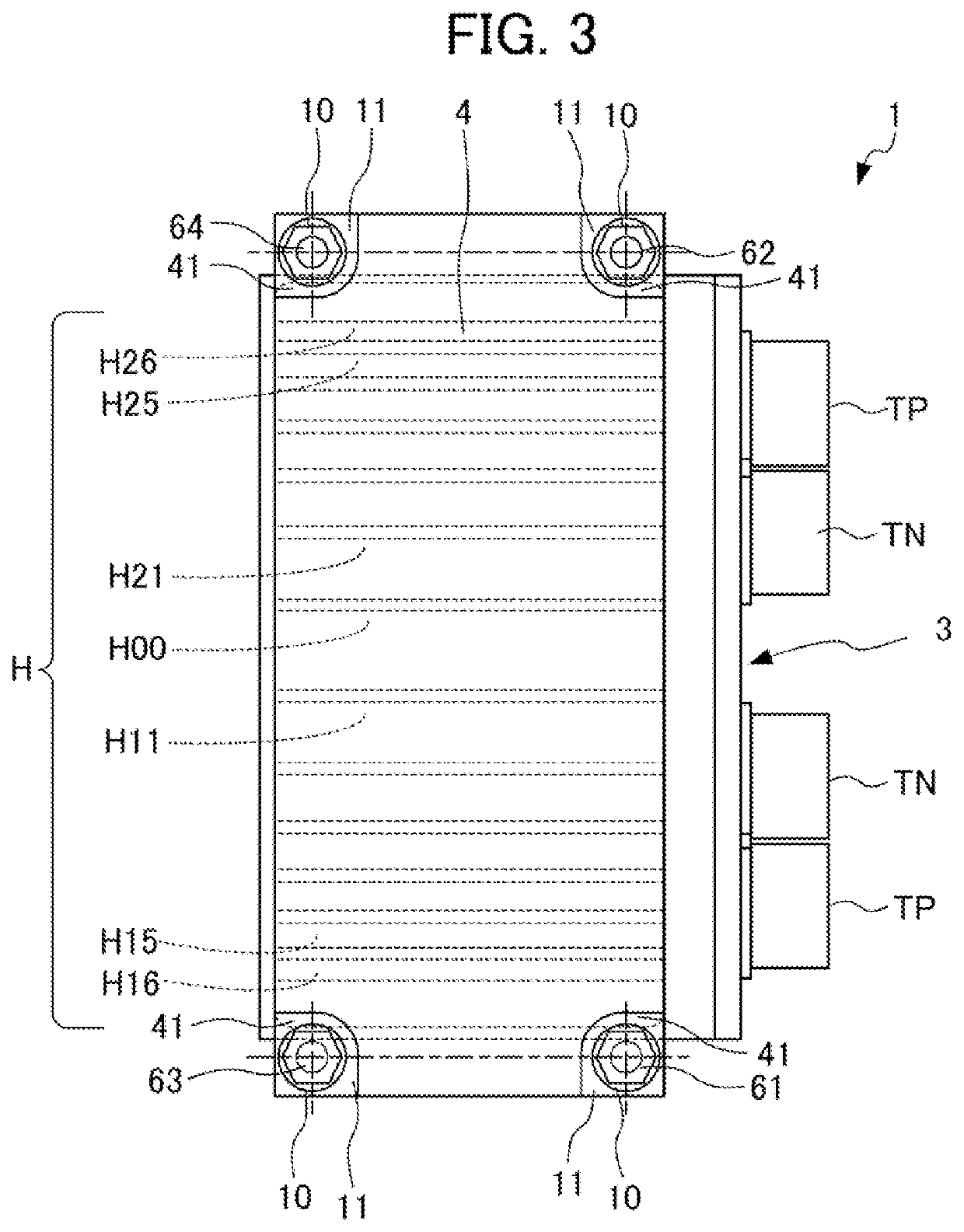Battery module
a battery module and battery technology, applied in the field of batteries, can solve the problems of not being able the inability to prevent the loosening of bolts and nuts during use, and the supposed detent at both ends, so as to reduce the weight of the rod-shaped connecting member
- Summary
- Abstract
- Description
- Claims
- Application Information
AI Technical Summary
Benefits of technology
Problems solved by technology
Method used
Image
Examples
first embodiment
[0041]Next, a first embodiment of the present invention will be described with reference to the drawings. In the drawings shown below, the same components and corresponding components are denoted by the same reference numeral. FIG. 1 is a plan view of a battery module according to a first embodiment of the present invention, FIG. 2 is a side view of the battery module of FIG. 1, FIG. 3 illustrates the battery module of FIG. 1 as viewed from one end plate side, and FIG. 4 illustrates the battery module of FIG. 1 as viewed from the other end plate side.
[0042]A battery module 1 of the first embodiment is configured such that a stacked body 3 of a plurality of battery cells 2 in a flat shape that is a stacked body of laminate pack lithium-ion battery cells is pinched and held by a first end plate 4 and a second end plate 5 from both end sides in the stacking direction. Each battery cell 2 is configured such that a laminated electrodes LE are packed with a laminate sheet, and a positive ...
second embodiment
[0058]Next, a second embodiment of the present invention will be described with reference to FIGS. 10 to 15. FIG. 10 illustrates a portion corresponding to the portion encircled with the circle C in FIG. 1 described above in an enlarged manner, in the second embodiment of the present invention. On the left side in FIG. 10, a portion of the first end plate 4 as viewed from the nut 10 side is illustrated. On the right side in FIG. 10, a portion of the second end plate 5 as viewed from the head portion 8 side is illustrated. FIG. 11 is a cross-sectional view taken along line A-A in FIG. 10. FIG. 12 illustrates the elements in FIG. 11 separately. FIG. 13 is a cross-sectional view taken along line B-B in FIG. 10. FIG. 14 illustrates the elements in FIG. 13 separately. FIG. 15 illustrates surroundings of a detent mechanism in FIG. 10 in an enlarged manner.
[0059]In the first connecting bolt 61, the nut 10 is screwed to the male threaded portion 9 on the first end plate 4 side, and the head...
third embodiment
[0065]Next, a third embodiment of the present invention will be described with reference to FIGS. 16 to 20. FIG. 16 illustrates a portion corresponding to the portion encircled with the circle C in FIG. 1 described above in an enlarged manner, in the third embodiment of the present invention. On the left side in FIG. 16, a portion of the first end plate 4 as viewed from the nut 10 side is illustrated. On the right side in FIG. 16, a portion of the second end plate 5 as viewed from the head portion 8 side is illustrated. FIG. 17 is a cross-sectional view taken along line A-A in FIG. 16. FIG. 18 illustrates the elements in FIG. 17 separately. FIG. 19 is a cross-sectional view taken along line B-B in FIG. 16. FIG. 20 illustrates the elements in FIG. 19 separately.
[0066]In the first connecting bolt 61, the nut 10 is screwed to the male threaded portion 9 on the first end plate 4 side, and the head portion 8 is formed on the second end plate 5 side. The pressing force from the nut 10 act...
PUM
| Property | Measurement | Unit |
|---|---|---|
| friction coefficient | aaaaa | aaaaa |
| tension | aaaaa | aaaaa |
| diameter | aaaaa | aaaaa |
Abstract
Description
Claims
Application Information
 Login to View More
Login to View More - R&D
- Intellectual Property
- Life Sciences
- Materials
- Tech Scout
- Unparalleled Data Quality
- Higher Quality Content
- 60% Fewer Hallucinations
Browse by: Latest US Patents, China's latest patents, Technical Efficacy Thesaurus, Application Domain, Technology Topic, Popular Technical Reports.
© 2025 PatSnap. All rights reserved.Legal|Privacy policy|Modern Slavery Act Transparency Statement|Sitemap|About US| Contact US: help@patsnap.com



